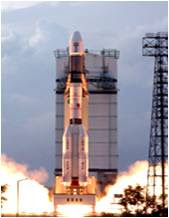‘India in space world’ deals with the space technologies around the world. More emphasize is given to Indian space technologies, Indian rockets (launch vehicles) & Indian satellites
How a Solid Rocket Motor works?
How a Solid Rocket Motor works?
- Heat sensitive charge of the initiating system is ignited by passing electric current through the embedded wire.
- The energy release system of igniter catches fire and delivers sustained heat energy to the propellant surface.
- Solid propellant which contains both oxygen and fuel burns and builds up pressure.
- Pressure stabilizes when rate of gas production equals rate of gas flow through the nozzle.
- Thrust is generated when hot gases pass through the nozzle.
Geo-Synchronous Satellite Launch Vehicle (GSLV)
Geo-Synchronous Satellite Launch Vehicle (GSLV)
ISRO developed a Geo-Synchronous Satellite Launch Vehicle (GSLV) by incorporating the PSLV solid and liquid stage technologies for the booster system and a cryogenic upper stage as a third stage. This vehicle is about 49 m tall with a lift-off mass of 400 t.
The first stage of GSLV comprises of solid propellant motor and four liquid propellant strap-on motors derived from the PSLV second stage. First stage is 20.3 m long and 2.8 m in diameter and carries 129 tons of Hydroxyl Terminated Poly Butadiene (HTPB) based solid propellant. The stage develops about 4700 kN thrust and burns for 100 s.
Four strap-on stages
The four strap-on stages are 19.70 m long and 2.1 m in diameter. The strapon liquid stage adopts VIKAS engine and stage is loaded with 40 tons of hypergolic propellants, namely, Unsymmetrical Di-Methyl Hydrazine (UDMH) as fuel and Nitrogen Tetroxide (N2O4) as oxidizer, stored in two separate tanks.
Second stage of GSLV
The second stage of GSLV is 11.6 m long and 2.8 m in diameter and loaded with 37.5 tonne of UDMH and N2O4 in two compartments of an aluminium alloy tank separated by a thin metal sheet known as common bulkhead. The VIKAS engine used for the second stage employs a turbo-pump system producing a thrust of about 700 kN in vacuum.
Third stage of GSLV
The third stage of GSLV uses a Cryogenic Stage (CS) which is procured from Russia. The stage, that employs liquid hydrogen and liquid oxygen as fuel and oxidizer respectively. It is 8.7 m long and 2.9 m in diameter. Liquid hydrogen and liquid oxygen (LOX) are stored in two separate aluminium alloy tanks. With a propellant loading of 12.5 tonne, the stage can burn for duration of about 750 s producing a nominal thrust of 75 kN.
The heat shield which protects the spacecraft during the flight is of 3.4 m diameter and 7.8 m long.
The first flight of GSLV was on April 18. 2001 and it successfully launched G-SAT spacecraft of 1540 kg into geo-synchronous transfer orbit.
The overall lift-off mass of the vehicle - 400 tons
Length of vehicle - 49m
Payload capacity of PSLV :
The first flight of GSLV was on April 18. 2001 and it successfully launched G-SAT spacecraft of 1540 kg into geo-synchronous transfer orbit.
The overall lift-off mass of the vehicle - 400 tons
Length of vehicle - 49m
Payload capacity of PSLV :
Low Earth Orbit (LEO) - 4.5 tons
Sun Synchronous Polar Orbit (SSPO) - 2.2 tons
Geo Transfer orbit (GTO) - 2 ton.
Comparison of Solid Rocket Motors around the world
Comparison
of Solid Rocket Motors around the world
Parameter
|
RSRM
(Space Shuttle)
|
P230
(Araine 5)
|
PS1
(S139)(PSLV/
GSLV)
|
S200
(LVM3)
|
Diameter (m)
|
3.7
|
3.05
|
2.8
|
3.2
|
Length (m)
|
38.2
|
27.0
|
20.2
|
24.9
|
Motor case material
|
D6AC
|
D6AC
|
M250
|
M250
|
Propellant mass (t)
|
504
|
237
|
138
|
207
|
Nozzle expansion ratio
|
7.7
|
11
|
9
|
12
|
Vacuum specific impulse (s)
|
268
|
275
|
270
|
274.5
|
Comparison of Solid Rocket Motors of Space Shuttle, Araine 5, PSLV, GSLV, and LVM3,
Comparison of RSRM, P230, S139 and S200 Solid Rocket Motors





